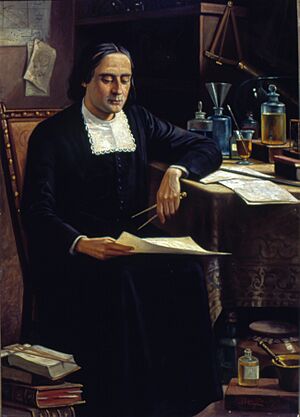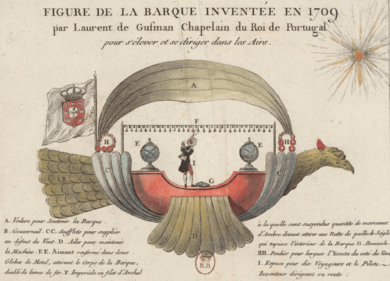Bartolomeu de Gusmão facts for kids
Quick facts for kids
Bartolomeu de Gusmão
|
|
|---|---|

Portrait of Bartolomeu de Gusmão by Benedito Calixto
|
|
| Born | December 1685 |
| Died | 18 November 1724 (aged 38) Toledo, Spain
|
| Nationality | Portuguese |
| Known for | Airship design |
|
Notable work
|
Passarola |
| Signature | |
Bartolomeu Lourenço de Gusmão (born December 1685 – died 18 November 1724) was a clever Portuguese priest and scientist from Colonial Brazil. He was one of the first people to design a machine that could fly in the air, like an airship! He is also a character in a famous book called Baltasar and Blimunda by José Saramago.
Early Life and Learning
Bartolomeu de Gusmão was born in Santos, São Paulo, which was then a Portuguese colony in Brazil.
When he was about 15 years old, he started training to become a priest with the Society of Jesus in Bahia. However, he left the order in 1701. He then moved to Portugal.
In Portugal, he found a supporter in the Marquis of Abrantes in Lisbon. Bartolomeu studied at the University of Coimbra. He focused on languages and mathematics. He was known for having an amazing memory and being good at many languages.
Designing an Airship
In 1709, Bartolomeu de Gusmão asked King João V of Portugal for help with his new invention. He was very confident about his airship design. We still have his request, along with a drawing and description of his airship.
He got some ideas from another inventor, Francesco Lana de Terzi. Gusmão wanted to put a huge sail over a boat-shaped body, like the cover of a wagon. The boat would have tubes. If there was no wind, air would be blown into the sail using special bellows. He even thought about using magnets to help the airship move!
A public test of his machine was planned for June 24, 1709, but it didn't happen.
However, Bartolomeu did show off his ideas at a public event on August 8, 1709. This happened in Lisbon, in the hall of the Casa da Índia. He managed to send a ball up to the roof using a burning process.
The king was impressed! He gave Bartolomeu a teaching job at Coimbra and made him a canon (a type of priest). In 1720, he became one of the fifty members of the Academia Real de História. In 1722, he became a chaplain for the royal court.
Bartolomeu also worked on other inventions. But he kept trying to improve his airship plans. He had thought of the idea when he was a young trainee in Bahia. His designs included a "ship to sail in the air" that looked like a triangle filled with gas. Sadly, he passed away before he could finish his flying machine.
Challenges and Later Life
Some stories say that the Portuguese Inquisition (a religious court) stopped Bartolomeu from working on his flying machines. They might have seen his inventions as strange or even magical. This idea probably became popular later, towards the end of the 1700s.
For example, a newspaper in London wrote in 1786 about Bartolomeu. It said that he built a balloon in 1720. One day, in front of the King and many people, he made it rise as high as a building's roof using fire. But because people holding the ropes weren't careful, it hit the building, burst, and fell.
The newspaper also said that his balloon looked like a bird with a tail and wings. It claimed that people called him a "wizard." It suggested that he was scared of the Inquisition, so he burned his notes, disguised himself, and ran away to Spain. He then died in a hospital there.
Records from that time do show that Bartolomeu faced some problems with the Inquisition, but for a different reason. He did flee to Spain and got sick with a fever, passing away in Toledo.
He wrote some books, including:
- Manifesto summário para os que ignoram poderse navegar pelo elemento do ar (Short Manifesto for those who are unaware that it is possible to sail through the element air, 1709)
- Vários modos de esgotar sem gente as naus que fazem água (Several ways of draining, without people, ships that leak water, 1710)
Some of his speeches were also printed.
His Legacy
Bartolomeu de Gusmão's ideas were remembered long after he died.
- In 1936, the Bartolomeu de Gusmão Airport was built in Rio de Janeiro, Brazil. It was used for large airships like the Graf Zeppelin and Hindenburg.
- In 1941, the airport became a military base called Santa Cruz Air Force Base.
- Today, the airport serving Araraquara is also named Bartolomeu de Gusmão Airport.
See also
- List of firsts in aviation
- List of Catholic clergy scientists


